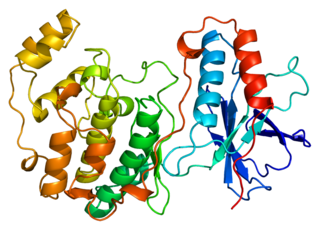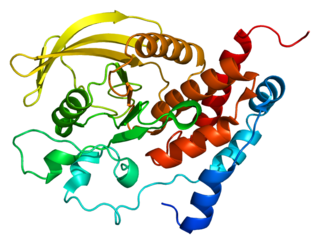Mitogen-activated protein kinase 3, also known as p44MAPK and ERK1, [5] is an enzyme that in humans is encoded by the MAPK3 gene. [6]
Mitogen-activated protein kinase 3, also known as p44MAPK and ERK1, [5] is an enzyme that in humans is encoded by the MAPK3 gene. [6]
The protein encoded by this gene is a member of the mitogen-activated protein kinase (MAP kinase) family. MAP kinases, also known as extracellular signal-regulated kinases (ERKs), act in a signaling cascade that regulates various cellular processes such as proliferation, differentiation, and cell cycle progression in response to a variety of extracellular signals. This kinase is activated by upstream kinases, resulting in its translocation to the nucleus where it phosphorylates nuclear targets. Alternatively spliced transcript variants encoding different protein isoforms have been described. [7]
It has been suggested that MAPK3, along with the gene IRAK1, is turned off by two microRNAs that were activated after the influenza A virus had been made to infect human lung cells. [8]
Pharmacological inhibition of ERK1/2 restores GSK3β activity and protein synthesis levels in a model of tuberous sclerosis. [9]
MAPK3 has been shown to interact with:
A mitogen-activated protein kinase is a type of protein kinase that is specific to the amino acids serine and threonine. MAPKs are involved in directing cellular responses to a diverse array of stimuli, such as mitogens, osmotic stress, heat shock and proinflammatory cytokines. They regulate cell functions including proliferation, gene expression, differentiation, mitosis, cell survival, and apoptosis.
Biological crosstalk refers to instances in which one or more components of one signal transduction pathway affects another. This can be achieved through a number of ways with the most common form being crosstalk between proteins of signaling cascades. In these signal transduction pathways, there are often shared components that can interact with either pathway. A more complex instance of crosstalk can be observed with transmembrane crosstalk between the extracellular matrix (ECM) and the cytoskeleton.
Mitogen Activated Protein (MAP) kinase kinase kinase, MAPKKK is a serine/threonine-specific protein kinase which acts upon MAP kinase kinase. Subsequently, MAP kinase kinase activates MAP kinase. Several types of MAPKKK can exist but are mainly characterized by the MAP kinases they activate. MAPKKKs are stimulated by a large range of stimuli, primarily environmental and intracellular stressors. MAPKKK is responsible for various cell functions such as cell proliferation, cell differentiation, and apoptosis. The duration and intensity of signals determine which pathway ensues. Additionally, the use of protein scaffolds helps to place the MAPKKK in close proximity with its substrate to allow for a reaction. Lastly, because MAPKKK is involved in a series of several pathways, it has been used as a therapeutic target for cancer, amyloidosis, and neurodegenerative diseases. In humans, there are at least 19 genes which encode MAP kinase kinase kinases:
The MAPK/ERK pathway is a chain of proteins in the cell that communicates a signal from a receptor on the surface of the cell to the DNA in the nucleus of the cell.
In molecular biology, extracellular signal-regulated kinases (ERKs) or classical MAP kinases are widely expressed protein kinase intracellular signalling molecules that are involved in functions including the regulation of meiosis, mitosis, and postmitotic functions in differentiated cells. Many different stimuli, including growth factors, cytokines, virus infection, ligands for heterotrimeric G protein-coupled receptors, transforming agents, and carcinogens, activate the ERK pathway.

Mitogen-activated protein kinase 1, (MAPK 1), also known as ERK2, is an enzyme that in humans is encoded by the MAPK1 gene.

Mitogen-activated protein kinase 14, also called p38-α, is an enzyme that in humans is encoded by the MAPK14 gene.

Mitogen-activated protein kinase 8 is a ubiquitous enzyme that in humans is encoded by the MAPK8 gene.

Dual specificity mitogen-activated protein kinase kinase 1 is an enzyme that in humans is encoded by the MAP2K1 gene.

Dual specificity mitogen-activated protein kinase kinase 2 is an enzyme that in humans is encoded by the MAP2K2 gene. It is more commonly known as MEK2, but has many alternative names including CFC4, MKK2, MAPKK2 and PRKMK2.

Mitogen-activated protein kinase 7 also known as MAP kinase 7 is an enzyme that in humans is encoded by the MAPK7 gene.

Dual specificity mitogen-activated protein kinase kinase 3 is an enzyme that in humans is encoded by the MAP2K3 gene.

Ribosomal protein S6 kinase alpha-5 is an enzyme that in humans is encoded by the RPS6KA5 gene. This kinase, together with RPS6KA4, are thought to mediate the phosphorylation of histone H3, linked to the expression of immediate early genes.

Ribosomal protein S6 kinase alpha-2 is an enzyme that in humans is encoded by the RPS6KA2 gene.

Protein tyrosine phosphatase non-receptor type 7 is an enzyme that in humans is encoded by the PTPN7 gene.

Protein tyrosine phosphatase receptor-type R is an enzyme that in humans is encoded by the PTPRR gene.

Dual specificity protein phosphatase 3 is an enzyme that in humans is encoded by the DUSP3 gene.

Mitogen-activated protein kinase scaffold protein 1 is a scaffold protein that in humans is encoded by the MAPKSP1 gene.

Dual specificity protein phosphatase 10 is an enzyme that in humans is encoded by the DUSP10 gene.

Dual specificity protein phosphatase 16 is an enzyme that in humans is encoded by the DUSP16 gene.